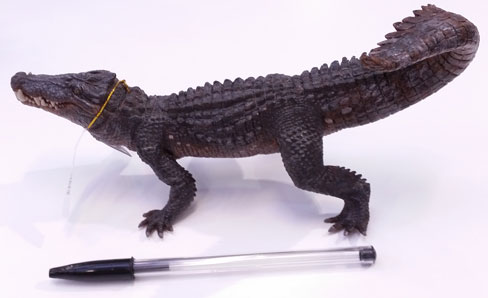Brazilian Palaeontologists report on new Genus of Crocodile from the Cretaceous
Crocodiles and their close relatives caiman, alligators and gharials are often described as living dinosaurs but although related to the Dinosauria (along with birds they are the last representatives of the Archosauria – the group of reptiles that gave rise to the dinosaurs), they are not dinosaurs as such.
However, they do represent a very ancient lineage and the crocodilian’s basic body plan has not changed for something like 240 million years. Now a team of palaeontologists from Brazil have published a paper on a new genus a crocodile – a semi-upright, long legged animal that wandered amongst the dinosaurs of the Late Cretaceous.
A Model of an Ancient Crocodilian (Papo Kaprosuchus)
Picture credit: Everything Dinosaur
There are several ancient crocodiles represented in model ranges from manufacturers. For example, Papo have created a model of Kaprosuchus. To view the Papo model range: Papo Prehistoric Animal Models and Figures.
Montealtosuchus
This fossil, which was found in 2004, near the town of Monte Alto, in San Paulo state is very well preserved and quite complete. Most importantly skull material has been found and this can help to link this fossil specimen with today’s modern crocodiles.
The fossil has been named Montealtosuchus arrudacamposi. It would have grown to about 2 metres in length and would have been an active predator of smaller animals including dinosaurs in the Brazilian Late Cretaceous. The relatively long limbs give scientists an indication about this animal’s behaviour. Perhaps it was more terrestrial than its modern descendants, using its semi-upright gait to pursue prey.
“This is scientifically important because the specimen literally is the link between more primitive crocodiles that lived in the era of the dinosaurs 80-85 million years ago and modern species,” said palaeontologist Ismar de Souza Carvalho of Rio de Janeiro Federal University, who is one of the scientists responsible for the study of this rare find.
To read an earlier blog post about a crocodile skull discovered in Dorset: Ancient Crocodile Skull Found in Dorset.
Crocodilians have many links to dinosaurs, they don’t just share a common ancestor. The name crocodilian was given to this group of reptiles by Sir Richard Owen in 1842; the same year that Sir Richard had his work on “Dinosauria” published and dinosaurs came into the scientific arena.







Leave A Comment